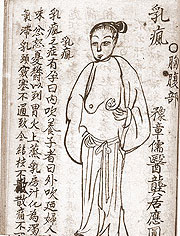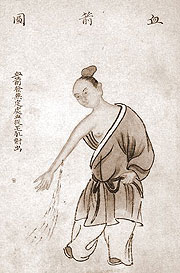
Breast abscess
In traditional Chinese medicine (TCM), internal medicine is the branch that deals with the diagnosis and treatment of internal organ systems, while external medicine is the branch concerned with the body’s surface. In AD 1516, Wang Ji defined the scope of external medicine, wai kei, in his work Theory and Examples of External Medicine (wai kei li li). The book states: “It is called external medicine because diseases such as carbuncles, sores, wounds and ulcers are all visible from the outside.” Thereafter, health problems that could be seen or touched directly, such as superficial infections, skin diseases, peripheral vascular problems, breast or thyroid lumps, male genital problems and piles as well as traumatic injuries, all came under the field of external medicine.

Arrow wounds
Unlike conventional medicine, TCM relies more on drug therapies than operative procedures on treating external conditions. The holistic view holds that the human body is an organic whole, with all parts being connected with one another by channels and collaterals (otherwise known as meridians). As a result, the internal is correlated with the external, and the exterior with the interior. For any superficial lesion, there must be deep influence to the internal system, and thus, treatment should cover both internal and external areas in order to exert both general and local therapeutic effects on the condition.
TCM external medicine first focused on serving the working class where wounds and infections more frequently occurred. This helped specialists accumulate knowledge on septic conditions and how to treat them using various local herbal remedies. From the Jin &Yuan Period onwards, physicians contributed significantly to the development of external medicine. A full set of pathological, diagnostic and therapeutic principles was also established at this time. Some classical works on external medicine are:
Essence of External Medicine (wai kei jing yao)
Written by Chen Ziming in AD 1263, this work focuses on the importance of identifying the nature of septic conditions (including cold, hot, excess and deficiency conditions); it also employed an integrated approach to treatment (of oral methods alongside external methods). This book marks the establishment of external medicine and traumatic surgery as independent branches of medicine.
Essentials of External Medicine (wai kei jing yi)
Written by Qi Dezhi in AD 1335, this book gathers together medical knowledge prior to the Yuan dynasty. By using a holistic view, the writer clarified that external diseases were mostly due to yin yang disharmony or blood and qi (vital energy) stagnations, and therefore diagnosis should be based on an overall analysis through the four examination skills. He also formulated some guidelines for internal treatment methods.
Orthodox External Medicine (wai kei zheng zong)
Written by Chen Sizong in AD 1617, this large book records the medical achievements of the time, and precisely outlines various surgical procedures and cancer therapies. The writer advocated fortifying the spleen and stomach in managing surgical cases.


